The Toponym Co-Occurrence Index: A New Method to Measure the Co-Occurrence Characteristics of Toponyms
Abstract
1. Introduction
2. Study Area and Data Sources
2.1. Regional Overview
2.2. Data Sources and Pre-Processing
3. Research Route and Technical Methods
3.1. Research Route
3.2. The LCLQ Method
3.3. Setting the Detection Bandwidth (R)
- (1)
- The global scale co-occurrence characteristic detection bandwidth (). The global scale was determined based on the 147,000 km2 global area of Liaoning Province and combined with the geographical boundaries of the province’s land area. Based on the geographical measurements shown in Figure 2, the straight-line distance from the southernmost to the northernmost point of the province was approximately 610 km, and the straight-line distance from the easternmost to the westernmost point was approximately 600 km. The bandwidth -value was calculated to be 650 km to ensure that all toponym groups within the neighbourhood range of the province-wide detection were included in the analysis.
- (2)
- The prefecture-level city-scale co-occurrence characteristics detection bandwidth (). Liaoning Province includes 14 prefecture-level cities. Detecting the spatial co-occurrence between toponym groups at the prefecture-level city scale is an important administrative scale for the application of the detection results to cities. The following formula is used:where is the radius of the equal-area circle area of each prefecture-level city, and is the area of land jurisdiction of the prefecture-level cities. Based on the calculation of the radius of the equal-area circle of the 14 prefecture-level cities, the average value of the 14 prefecture-level cities was 56.79 km, and the nearest integer of 60 km was taken as the prefectural city-scale co-occurrence characteristic detection bandwidth.
- (3)
- The regional cultural unit co-occurrence characteristic detection bandwidth (). Based on these 14 prefecture-level cities, Liaoning Province was further divided into 46 regional cultural units (Figure 2). Detecting co-occurrence features between toponym groups at the regional cultural unit spatial scale not only yields more precise detection results but also has potential applications in the construction of county-level toponym cultural landscapes. Using the same method for determining the co-occurrence feature detection bandwidth at the prefecture-level city scale, the average radius of the equal-area circles for the 46 regional cultural units was calculated to be 31.17 km. A rounded value of 30 km was selected as the regional cultural unit-scale co-occurrence feature detection bandwidth.
3.4. Construction of the TCOI
- (1)
- The TCOI ()
- (2)
- The single bandwidth TCOI ()
- (3)
- The composite bandwidth TCOI ()
- (4)
- The global TCOI ()
4. Result Analysis
4.1. Multi-Bandwidth LCLQ Detection Results for the Toponym Groups
4.1.1. Puzi with the Other Toponym Groups
4.1.2. Zhangzi with the Other Toponym Groups
4.1.3. Wopu with the Other Toponym Groups
4.1.4. Yingzi with the Other Toponym Groups
4.1.5. Jiazi with the Other Toponym Groups
4.2. Analysis of the TCOI Calculation Results and Co-Occurrence Characteristics
4.3. Recommended Reference Thresholds for the Evaluation of Toponym Co-Occurrence Features
5. Discussion
5.1. Applicability and Expansibility of the TCOI
5.1.1. A Larger Number of High-Frequency Single-Character Toponym Groups
5.1.2. A Smaller Number of Low-Frequency Toponym Groups
5.2. Research Innovation and Contributions
5.2.1. Enrichment and Expansion of the Field of Toponym Econometric Research
5.2.2. The Proposal of a Basic Framework for Spatial Co-Occurrence Research of Toponym Groups and a TCOI
5.2.3. The First Application of the LCLQ Method in Toponym Co-Occurrence Research
5.2.4. Contribution to Empirical Research in Liaoning Province
5.3. Limitations and Future Research Directions
6. Conclusions
Author Contributions
Funding
Data Availability Statement
Acknowledgments
Conflicts of Interest
Abbreviations
| SDE | Standard deviation ellipse |
| KDE | Kernel density estimation |
| TCOI | Toponymic co-occurrence index |
| LCLQ | Local co-location quotient |
| POI | Point of interest |
| CLQs | Co-location quotients |
| GCLQs | Global colocation quotients |
References
- Perono Cacciafoco, F.; Cavallaro, F. Place Names: Approaches and Perspectives in Toponymy and Toponomastics; Cambridge University Press: Cambridge, MA, USA, 2023; pp. 1–23. [Google Scholar] [CrossRef]
- Jones, C.B.; Abdelmoty, A.I.; Finch, D.; Fu, G.; Vaid, S. The SPIRIT Spatial Search Engine: Architecture, Ontologies and Spatial Indexing; Springer: Berlin/Heidelberg, Germany, 2004; pp. 125–139. [Google Scholar] [CrossRef]
- Pinna, S. Cartographic erasure of landscape as a social concept: Changes in ancient rural practices and land-use policy behind the study of toponyms. A case study from Sardinia. Catena 2023, 229, 107229. [Google Scholar] [CrossRef]
- De Felice, P.; La Greca, F.; Siniscalchi, S. The place names of the Aragonese maps. Interpretative hypotheses, landscape readings and methodological proposals. Int. J. Cartogr. 2022, 8, 3–17. [Google Scholar] [CrossRef]
- Jiao, M.; Lu, L. Spatiotemporal distribution of toponymic cultural heritage in Jiangsu Province and its historical and geographical influencing factors. Herit. Sci. 2024, 12, 377. [Google Scholar] [CrossRef]
- Lu, Q.; Sun, P.; Wang, S.; Xiang, H.; Wang, S. Spatial distribuion and genesis of the cutural landscape of vilage names inthe Chongqing section of the Three Gorges Reservoir area in China. Mt. Res. 2024, 42, 108–122. [Google Scholar] [CrossRef]
- Zhi, L.; Li, R.; Fu, X.; Guo, F. Data mining method of hot-toponym and its co-occurrence in crowdsourcing text written by tourists. Sci. Surv. Mapp. 2016, 41, 144–151. [Google Scholar] [CrossRef]
- Amandanu, R.; Arijuddin, B.I.; Jauhari, A.; Ariseno, I.A. Toponymy analysis as geosocial cultural approach on disaster mitigation studies in Sumberagung Village Pracimantoro District Wonogiri Regency. IOP Conf. Ser. Earth Environ. Sci. 2024, 1314, 12122. [Google Scholar] [CrossRef]
- Wang, R.; Liu, Y.; Xu, Y. The construction of theoretical system of touristic toponymy. J. Arid Land Resour. Environ. 2021, 35, 167–174. [Google Scholar] [CrossRef]
- Jett, S.C. Place-naming, environment, and perception among the Canyon de Chelly Navajo of Arizona. Prof. Geogr. 1997, 49, 481–493. [Google Scholar] [CrossRef]
- Fagúndez, J.; Izco, J. Diversity patterns of plant place names reveal connections with environmental and social factors. Appl. Geogr. 2016, 74, 23–29. [Google Scholar] [CrossRef]
- Membrado-Tena, J.C. Interpreting protohistoric societies through place names of landscape features: A case study in València, Spain. Landsc. Res. 2021, 46, 811–827. [Google Scholar] [CrossRef]
- Cao, Y.; Xing, H.; Cui, B. Knowledge graph construction of toponymic evolution. Sci. Surv. Mapp. 2025, 50, 127–142. [Google Scholar] [CrossRef]
- Sharma, P.; Samal, A.; Soh, L.; Joshi, D. A spatially-aware algorithm for location extraction from structured documents. Geoinformatica 2023, 27, 645–679. [Google Scholar] [CrossRef]
- Zhao, S.; Hu, X.; Tang, J.; Zheng, X.; Jin, X.; Wei, B. Characteristics of cultural landscape genome maps and groups: A study on names of ancient towns in Hunan Yuanshui Basin. Geogr. Res. 2023, 42, 3020–3042. [Google Scholar] [CrossRef]
- Sun, B.; Guo, C.; Yang, Y.; Ge, W. Spatial distribution characteristics of rural place-name cultural landscape based on GIS approach in Chengde. Sci. Geogr. Sin. 2017, 37, 244–251. [Google Scholar] [CrossRef]
- Li, J.; Xiao, Y.; Yan, J.; Liang, C.; Zhong, H. Spatiotemporal evolution characteristics and causative analysis of toponymic cultural landscapes in traditional villages in northern Guangdong, China. Sustainability 2025, 17, 271. [Google Scholar] [CrossRef]
- Xia, Z.; Jin, S.; Liu, Y. Analysis on spatial distribution and regional characteristics of place names inthe China-North Korea border: Take the place names of Yanbian and Hamgyöngbuk-do as an example. World Reg. Stud. 2023, 32, 50–62. [Google Scholar] [CrossRef]
- Zeini, N.T.; Abdel-Hamid, A.M.; Soliman, A.S.; Okasha, A.E. An exploratory study of place-names in Sinai Peninsula, Egypt: A spatial approach. Ann. GIS 2018, 24, 177–194. [Google Scholar] [CrossRef]
- Kotowski, M.; Nowak, A. Tracing vegetation changes through the testimony of early settlers: A spatio-temporal analysis of plant-based place names as ecological evidence. Glob. Ecol. Conserv. 2025, 59, e3552. [Google Scholar] [CrossRef]
- Wang, T.; Wu, Y.; Li, C.; Li, J.; Chen, C.; Ge, X.; Liu, Y. Construction of genetic information chain and bionic model of geo-graphical names and cultural landscapes: An example of geographical names of the South China Sea Islands. World Reg. Stud. 2023, 32, 28–40. [Google Scholar] [CrossRef]
- Wang, W.; Shi, Q.; Wang, G. Analysis of performance and genetic characteristics of cultural landscapes in traditional villages along the Jinzhong Section of the Wanli Tea Road from a landscape gene information chain perspective: A case study of Xiamen village. Sustainability 2024, 16, 8131. [Google Scholar] [CrossRef]
- Ma, R.; Chen, J. The spatial pattern and influencing factors of the cultural landscape of generic place names in the Yangtze River Delta. Geogr. Res. 2022, 41, 764–776. [Google Scholar] [CrossRef]
- Zhang, H. Geo-Informatic Graph Based Generation Method for Place-Name Culture—A Case Study of Village Name in China. Ph.D. Thesis, Nanjing Normal University, Nanjing, China, 2020. [Google Scholar]
- Wang, F.; Wang, G.; Hartmann, J.; Luo, W. Sinification of Zhuang place names in Guangxi, China: A GIS-based spatial analysis approach. Trans. Inst. Br. Geogr. 2012, 37, 317–333. [Google Scholar] [CrossRef]
- Liu, F.; Meng, K. Analysis of geomorphic environment elements and landscape features of cultural administrative place names. Arab. J. Geosci. 2021, 14, 1684. [Google Scholar] [CrossRef]
- Dong, X. The Study of Human Geographic Features and Spatial Distribution in Chinese Toponymy. Master’s Thesis, Shanxi Normal University, Taiyuan, China, 2012. [Google Scholar]
- Garcia-Quera, N. The etymology of opaque place names based on a cognitive and interdisciplinary method. Lang. Sci. 2025, 107, 101688. [Google Scholar] [CrossRef]
- Ursini, F.; Zhang, Y.S. Place and place names: A unified model. Front. Psychol. 2023, 14, 1237422. [Google Scholar] [CrossRef]
- Cavallaro, F.; Perono Cacciafoco, F.; Tan, Z.X. Sequent occupance and toponymy in Singapore: The diachronic and synchronic development of urban place names. Urban Sci. 2019, 3, 98. [Google Scholar] [CrossRef]
- Basik, S. Problematizing urban microtoponyms. Geogr. Compass 2024, 18, e12732. [Google Scholar] [CrossRef]
- Wu, J.; Feng, Z.; Zhang, X.; Xu, Y.; Peng, J. Delineating urban hinterland boundaries in the Pearl River Delta: An approach integrating toponym co-occurrence with field strength model. Cities 2020, 96, 102457. [Google Scholar] [CrossRef]
- Mitxelena-Hoyos, O.; Amaro-Mellado, J. A Comparison of Cartographic and Toponymic Databases in a Multilingual Environment: A Methodology for Detecting Redundancies Using ETL and GIS Tools. ISPRS Int. J. Geoinf. 2023, 12, 70. [Google Scholar] [CrossRef]
- Isoda, Y.; Muranaka, A.; Tanibata, G.; Hanaoka, K.; Ohmura, J.; Tsukamoto, A. Strengths of exaggerated tsunami-originated placenames: Disaster subculture in Sanriku Coast, Japan. ISPRS Int. J. Geoinf. 2019, 8, 429. [Google Scholar] [CrossRef]
- Wang, Y.; Ge, D.; Zhang, T.; Wang, Y. The sustainable development of choronymic cultural landscapes in China based on geo-informatic tupu. Sustainability 2019, 11, 4302. [Google Scholar] [CrossRef]
- Bréelle, D. French names bestowed by the Baudin expedition along the coasts of Australia: A snapshot of French national spirit during Napoleonic times. J. Hist. Geogr. 2024, 86, 47–66. [Google Scholar] [CrossRef]
- Wang, F.; Zhang, L.; Zhang, G.; Zhang, H. Mapping and spatial analysis of multiethnic toponyms in Yunnan, China. Cartogr. Geogr. Inf. Sci. 2014, 41, 86–99. [Google Scholar] [CrossRef]
- Cui, L.; Jiao, X. Dalian place name culture research. Sinogram Cult. 2025, 37, 4–6. [Google Scholar] [CrossRef]
- Feng, S.; Yang, C.; Cao, F.; Zhang, Q. Spatial distribution characteristics and causes of cultural landscape of rural place names in multi-ethnic integration zone-Taking Chaoyang City, Liaoning Province as an example. J. Northwest Norm. Univ. (Nat. Sci. Ed.) 2019, 55, 129–134. [Google Scholar] [CrossRef]
- Gai, Y. Sociolinguistic Study of Panjin Place Names. Master’s Thesis, Liaoning Normal University, Dalian, China, 2018. [Google Scholar]
- Wu, C. The review and prospect of the research on the geographical names in Liaoning Province. J. Hulunbuir Univ. 2023, 31, 80–84. [Google Scholar]
- Xi, X.; Bi, Y. Analysis of the types and main characteristics of island place names in Liaoning. Mar. Inf. 2016, 31, 39–42. [Google Scholar]
- Zhao, X. Liaoning High-Frequency Place Names. Available online: http://epaper.lnd.com.cn/lnrbepaper/pc/layout/202111/17/node_15.html (accessed on 10 June 2024).
- Wang, Y. The characteristics of the local pulse of the cultural landscape of the street toponymic names in Dalian city. Territ. Nat. Resour. Stud. 2019, 41, 66–69. [Google Scholar] [CrossRef]
- Chen, B. Rename in county-to-city upgrading in China since the reform and opening-up. Geogr. Res. 2019, 38, 1222–1235. [Google Scholar]
- Zhao, F.; Fu, Y.; Luan, G.; Zhang, S.; Cai, J.; Ding, J.; Qian, J.; Xie, Z. Spatial-temporal characteristic analysis of ethnic toponyms based on spatial information entropy at the rural level in northeast China. Entropy 2020, 22, 393. [Google Scholar] [CrossRef]
- Leslie, T.F.; Kronenfeld, B.J. The colocation quotient: A new measure of spatial association between categorical subsets of points. Geogr. Anal. 2011, 43, 306–326. [Google Scholar] [CrossRef]
- Cromley, R.G.; Hanink, D.M.; And Bentley, G.C. Geographically weighted colocation quotients: Specification and application. Prof. Geogr. 2014, 66, 138–148. [Google Scholar] [CrossRef]
- Wang, F.; Hu, Y.; Wang, S.; And Li, X. Local indicator of colocation quotient with a statistical significance test: Examining spatial association of crime and facilities. Prof. Geogr. 2017, 69, 22–31. [Google Scholar] [CrossRef]
- Liu, H.; Kwan, M.; Hu, M.; Wang, H.; Zheng, J. Application of the local colocation quotient method in jobs-housing balance measurement based on mobile phone data: A case study of Nanjing City. Comput. Environ. Urban Syst. 2024, 109, 102079. [Google Scholar] [CrossRef]
- Meng, B.; Gao, L.; Li, R. Spatial correlation analysis of residential and employment elements in Beijing based on collaborative location quotient. Acta Geogr. Sin. 2021, 76, 1380–1393. [Google Scholar] [CrossRef]
- Li, L.; Cheng, J.; Bannister, J.; And Mai, X. Geographically and temporally weighted co-location quotient: An analysis of spatiotemporal crime patterns in greater Manchester. Int. J. Geogr. Inf. Sci. 2022, 36, 918–942. [Google Scholar] [CrossRef]
- Pan, X.; Jin, C.; Zhang, S.; Chen, Y. Spatial correlation and influencing factors of the food retail industry site selection: Take cafes and tea houses in Shanghai as an example. Econ. Geogr. 2023, 43, 231–239. [Google Scholar] [CrossRef]
- Pei, Z.; Li, J.; Guo, J.; Li, Q.; Chen, J. Using local co-location quotient and niche-based model to assess fire risk in urban environments: A case study of Beijing, China. Sustain. Cities Soc. 2023, 99, 104989. [Google Scholar] [CrossRef]
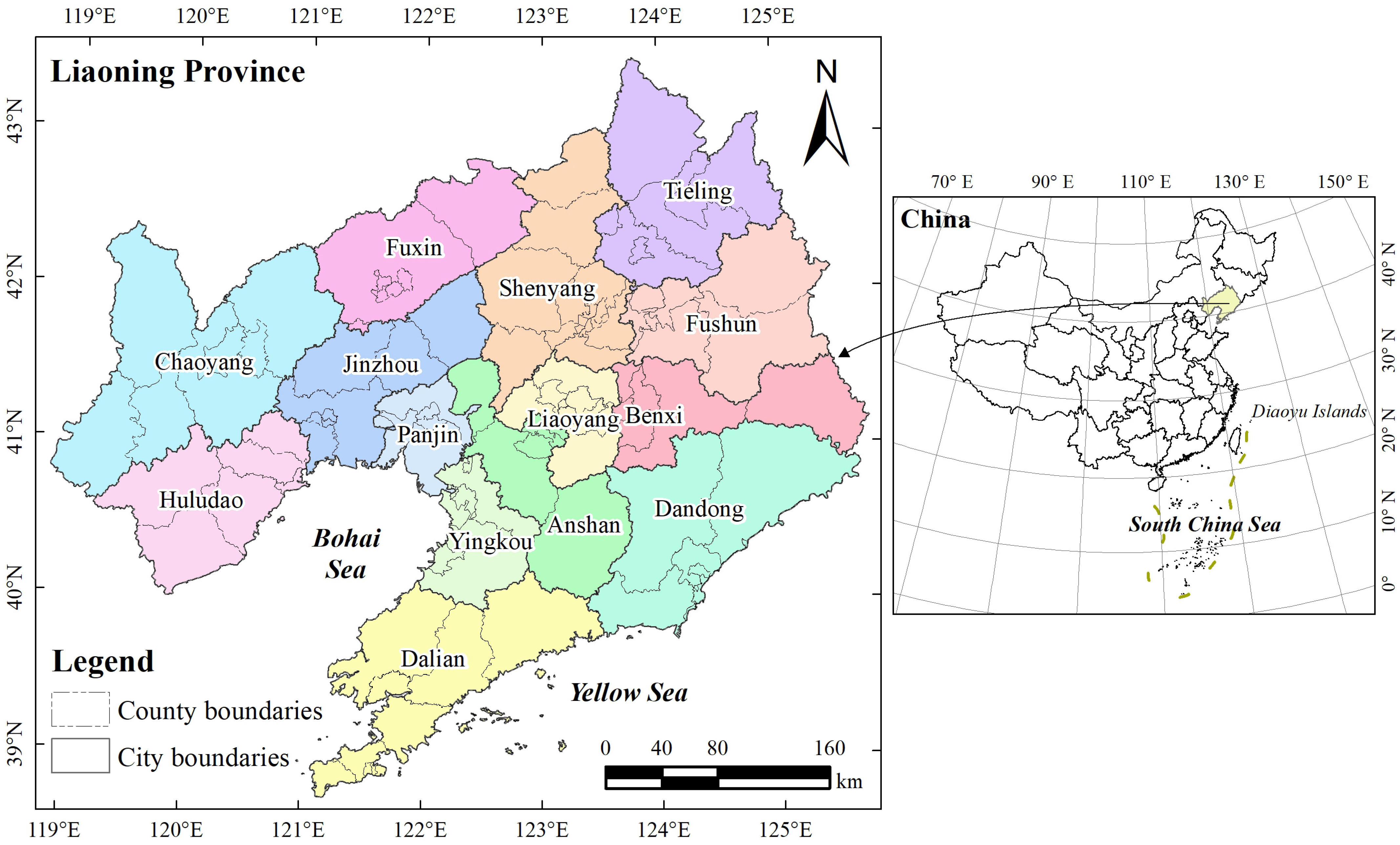
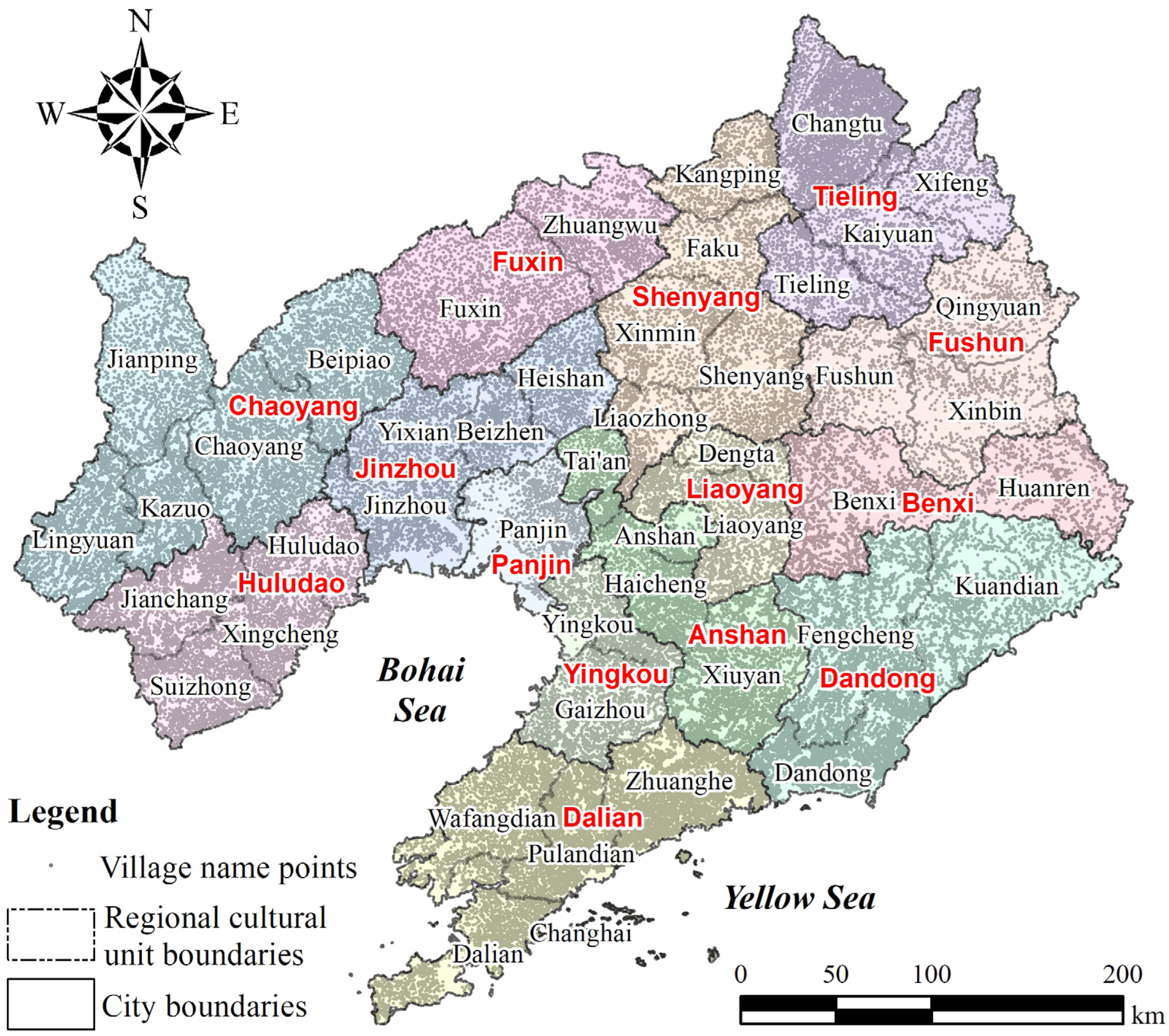
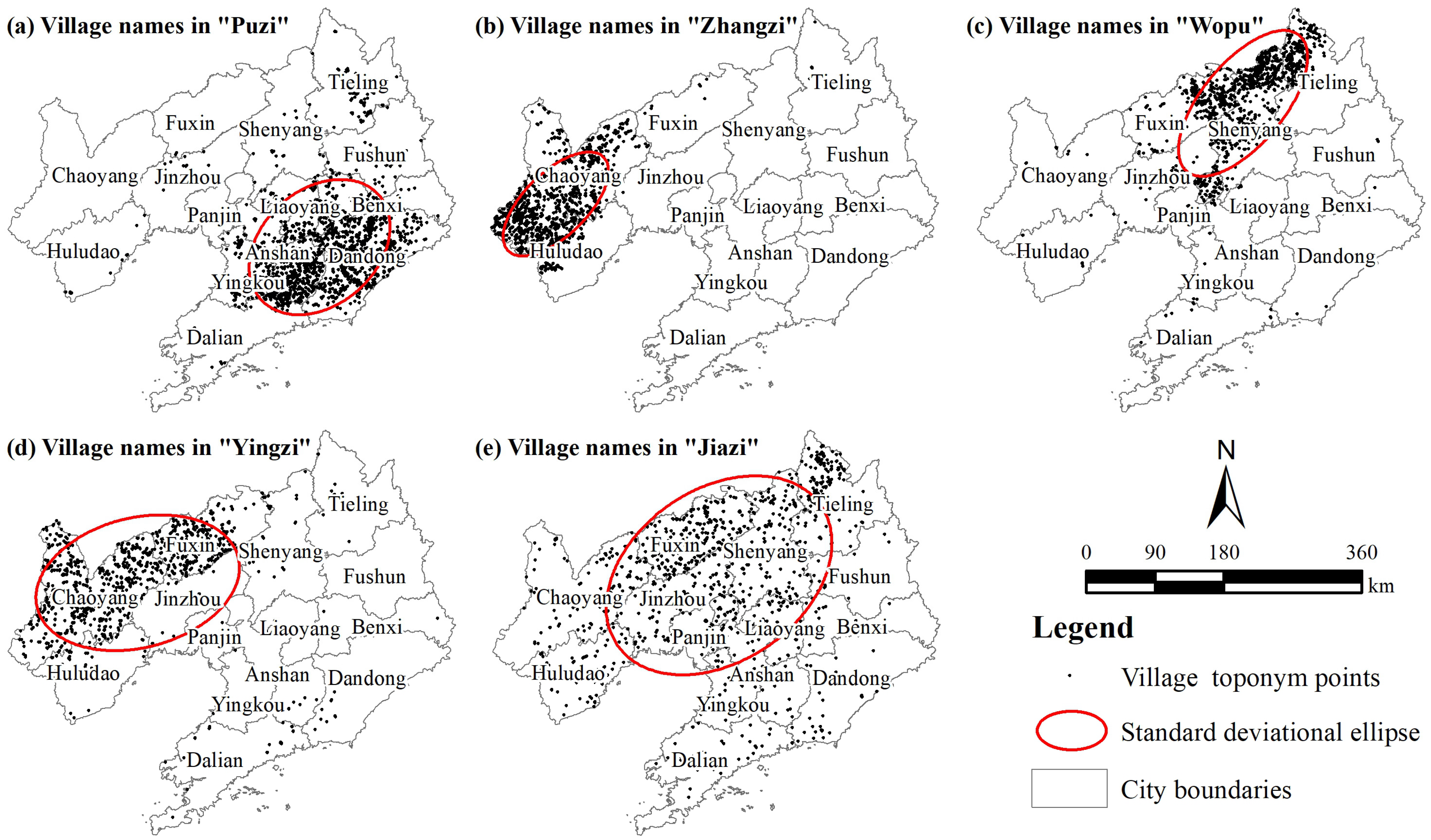
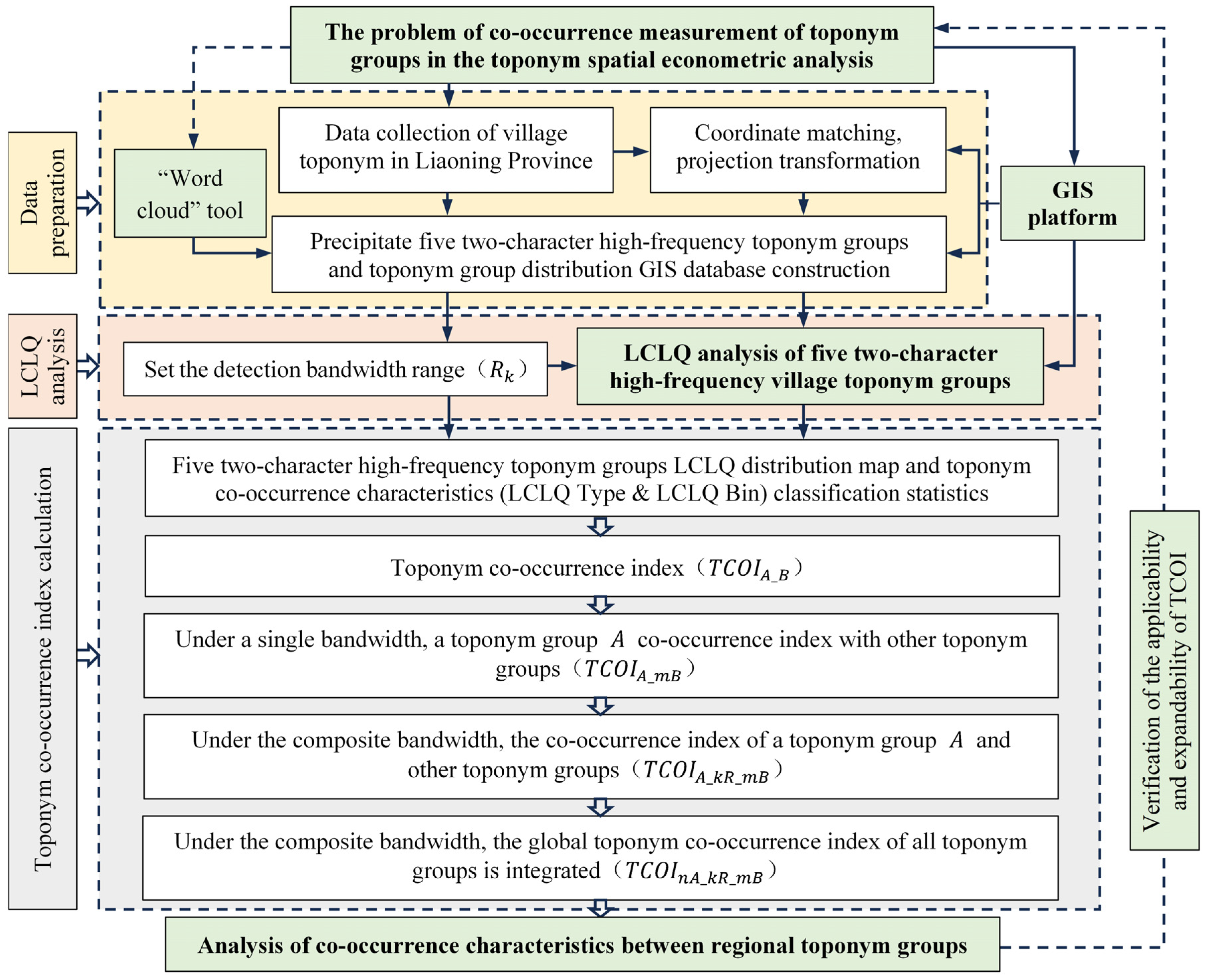



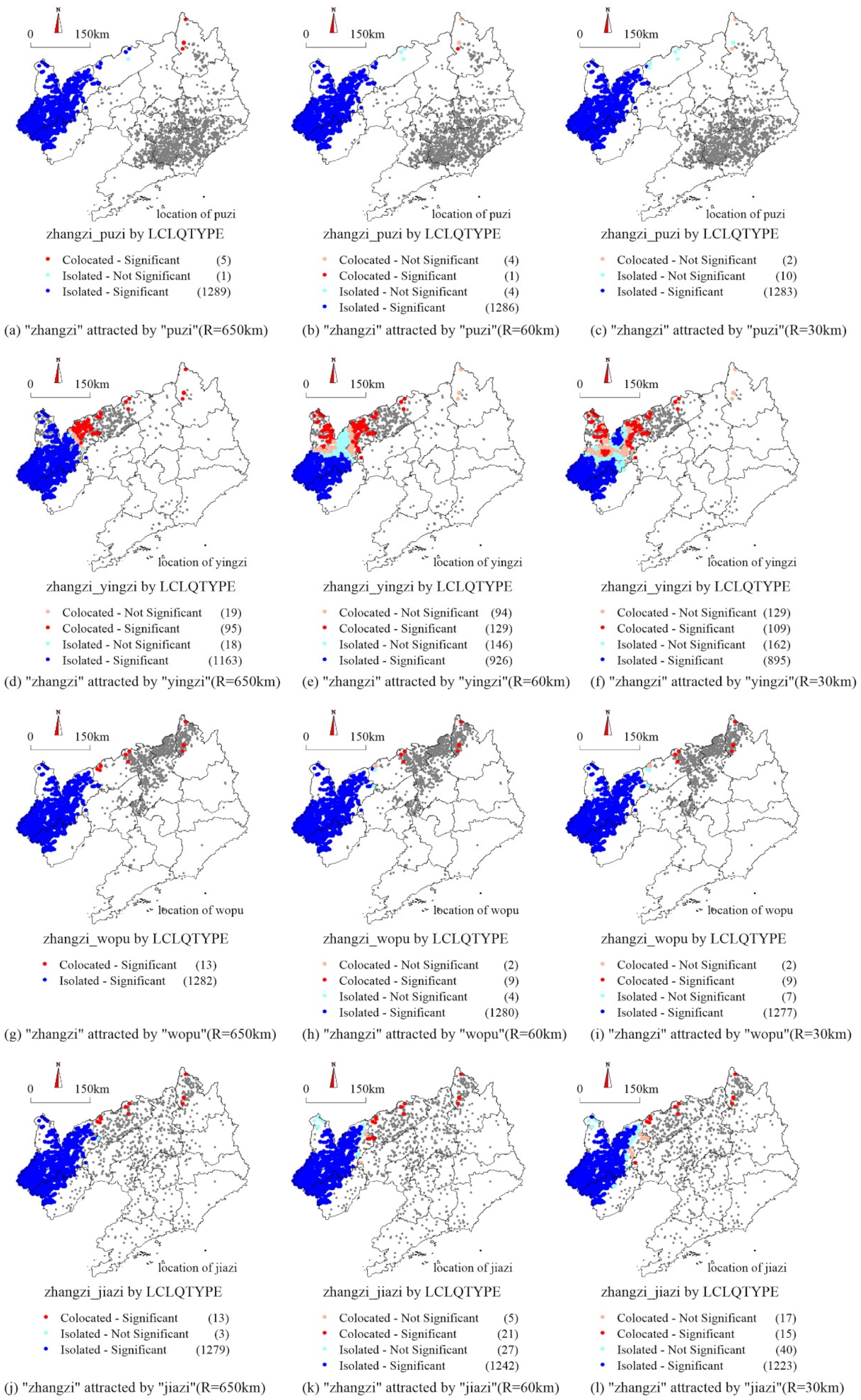


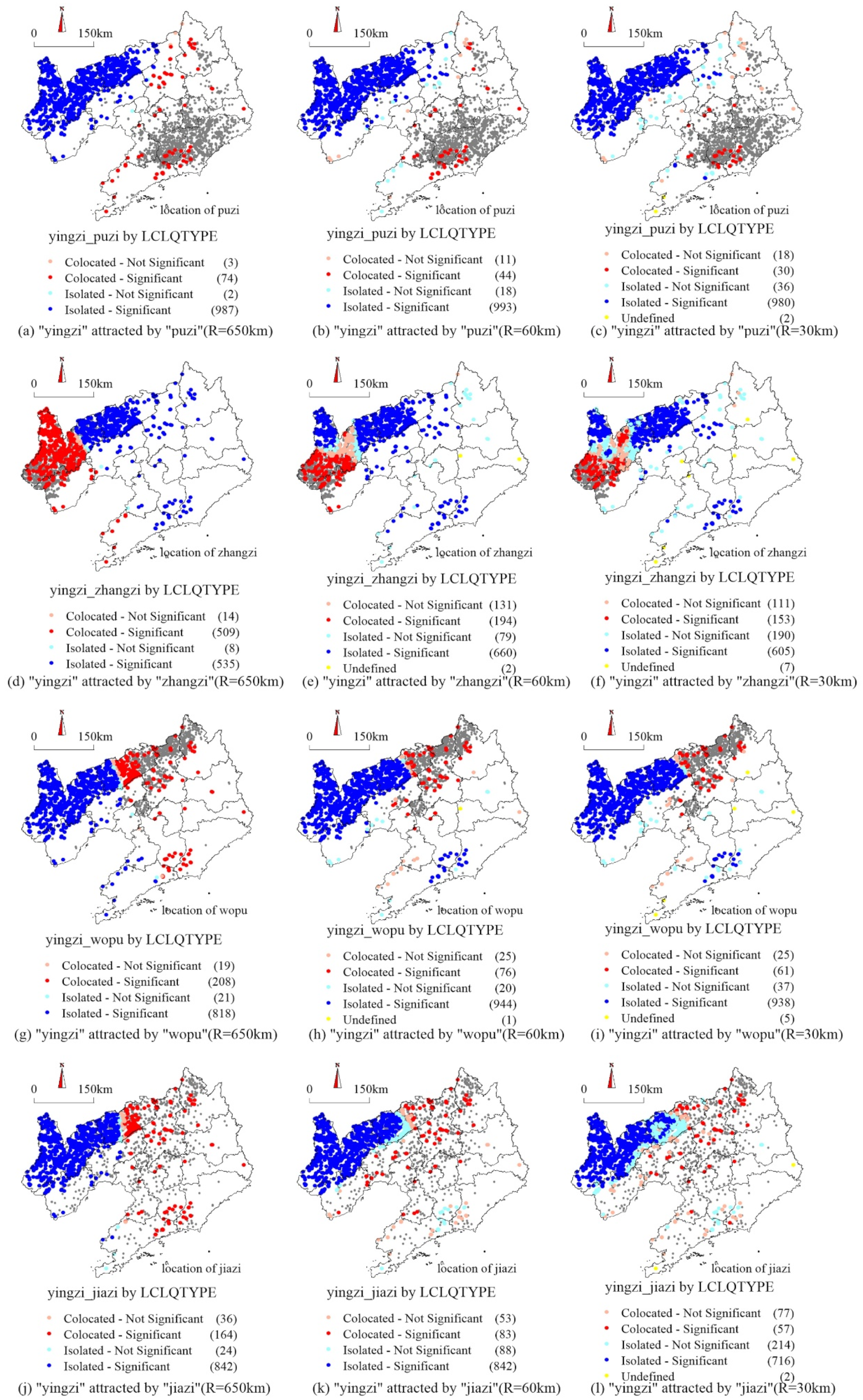
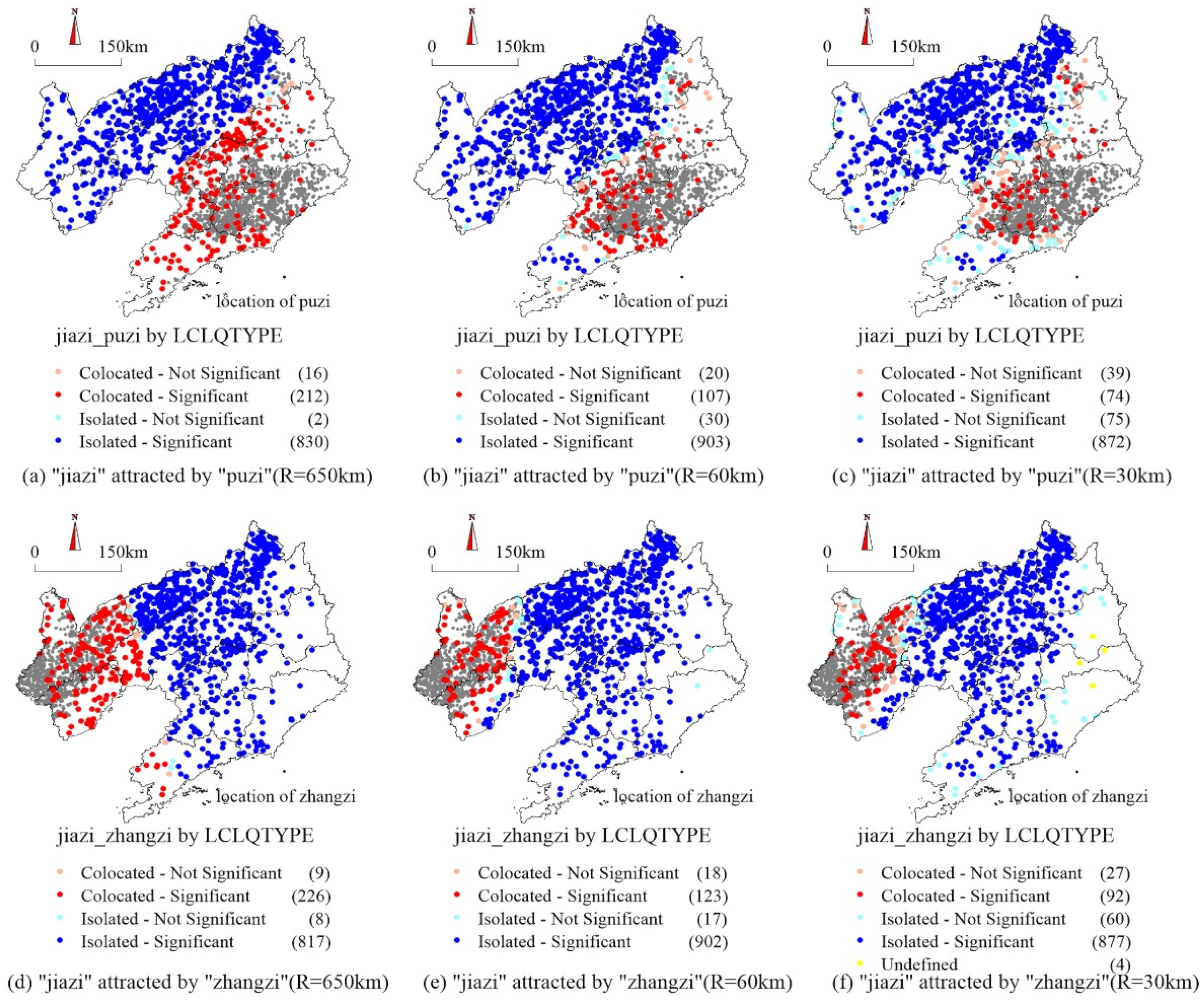

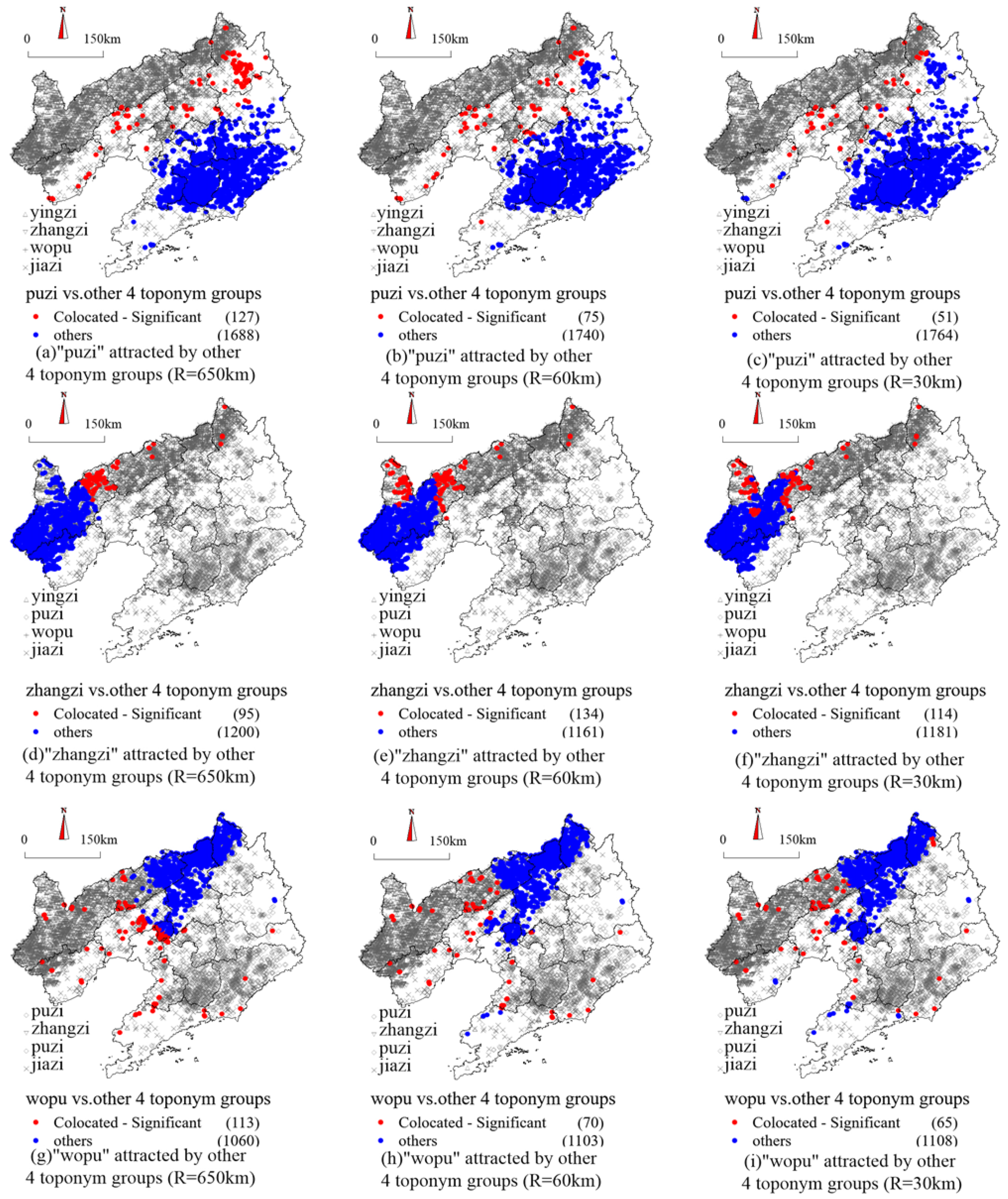


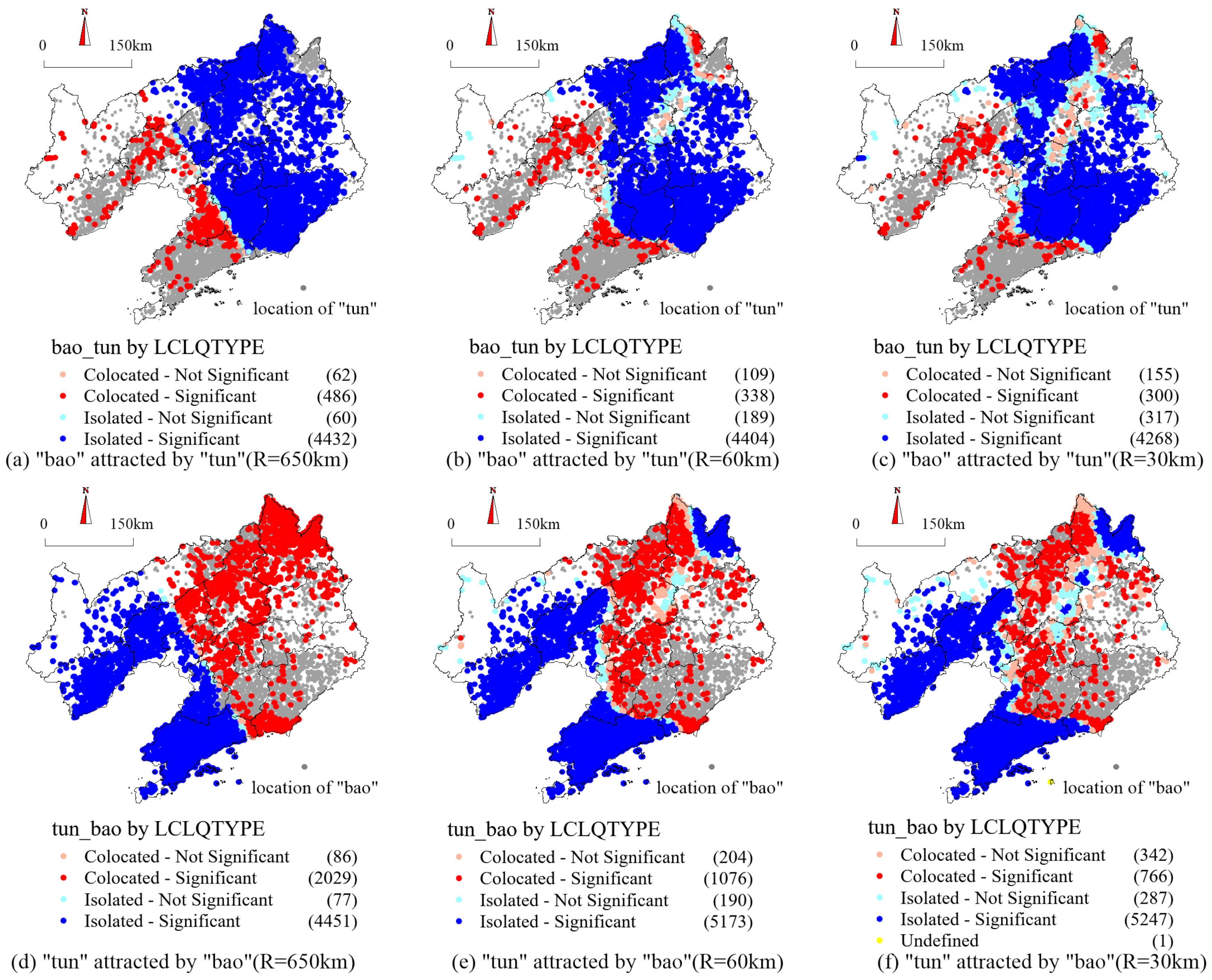


| Types | Co-Location Type | LCLQ Bin | Statistical Characteristics Description | The Co-Occurrence Characteristics of Toponyms |
|---|---|---|---|---|
| 01 | Co-located—Significant | 0 | In a certain neighbourhood or bandwidth range, > 1, and statistical significance p value < 0.05. | Within the determined neighbourhood or bandwidth range, the relevant group toponyms and group toponyms showed statistically significant spatial co-occurrence characteristics, reflecting clear mutual toponymic culture integration. |
| 02 | Co-located—Not Significant | 1 | In a certain neighbourhood or bandwidth range, > 1, and statistical significance p value > 0.05. | Within the determined neighbourhood or bandwidth range, the relevant group toponyms and group toponyms showed statistically insignificant spatial co-occurrence characteristics, reflecting clear mutual toponymic culture integration. |
| 03 | Isolated—Significant | 2 | In a certain neighbourhood or bandwidth range, ≤ 1, and the statistical significance p value < 0.05. | Within the determined neighbourhood or bandwidth range, the relevant group toponyms and group toponyms showed statistically significant spatial exclusion characteristics, reflecting clear mutual toponymic culture exclusivity. |
| 04 | Isolated—Not Significant | 3 | In a certain neighbourhood or bandwidth range, ≤ 1, and statistical significance p value > 0.05. | Within the determined neighbourhood or bandwidth range, the relevant group toponyms and group toponyms showed statistically insignificant spatial exclusion characteristics, reflecting clear mutual toponymic culture exclusivity. |
| 05 | Undefined | 4 | does not have any group toponyms within a defined neighbourhood or bandwidth. | In such cases, there was no spatial correlation between group and group toponyms in the determined neighbourhood or bandwidth range. |
| Village Toponym Groups | Bandwidths/km | |||
|---|---|---|---|---|
| = 650 | = 60 | = 30 | ||
| Puzi | 1815 | 1815 | 1815 | |
| 127 | 75 | 51 | ||
| 7.00% | 4.13% | 2.81% | ||
| 263 | 146 | 83 | ||
| 0.848 | 0.835 | 0.799 | ||
| 5.94% | 3.45% | 2.24% | ||
| 4.17% | ||||
| Zhangzi | 1295 | 1295 | 1295 | |
| 95 | 134 | 114 | ||
| 7.34% | 10.35% | 8.80% | ||
| 126 | 160 | 133 | ||
| 0.759 | 0.739 | 0.735 | ||
| 5.57% | 7.65% | 6.47% | ||
| 6.62% | ||||
| Wopu | 1173 | 1173 | 1173 | |
| 113 | 70 | 65 | ||
| 9.63% | 5.97% | 5.54% | ||
| 212 | 138 | 111 | ||
| 0.828 | 0.838 | 0.808 | ||
| 7.97% | 5.00% | 4.48% | ||
| 6.02% | ||||
| Yingzi | 1066 | 1066 | 1066 | |
| 726 | 319 | 254 | ||
| 68.11% | 29.92% | 23.83% | ||
| 955 | 397 | 301 | ||
| 0.757 | 0.747 | 0.738 | ||
| 51.57% | 22.35% | 17.58% | ||
| 34.00% | ||||
| Jiazi | 1060 | 1060 | 1060 | |
| 1002 | 704 | 466 | ||
| 94.53% | 66.42% | 43.96% | ||
| 1324 | 808 | 540 | ||
| 0.758 | 0.732 | 0.734 | ||
| 71.66% | 48.61% | 32.25% | ||
| 53.35% | ||||
| TCOI | Threshold Range and Co-Occurrence Characteristics Evaluation |
|---|---|
| There is strong co-occurrence between toponym groups. | |
| There is relatively strong co-occurrence between toponym groups. | |
| There is a certain degree of co-occurrence between toponym groups. | |
| There is weak co-occurrence between toponym groups, showing certain characteristics of mutual exclusion. | |
| There is very weak co-occurrence between toponym groups, with significant characteristics of mutual exclusion. |
| Village Toponym Groups | Bandwidths/km | |||
|---|---|---|---|---|
| R1 = 650 | R2 = 60 | R3 = 30 | ||
| Bao | 486 | 338 | 300 | |
| 5040 | 5040 | 5040 | ||
| 9.64% | 6.71% | 5.95% | ||
| 7.60% | ||||
| Tun | 2029 | 1076 | 766 | |
| 6643 | 6643 | 6643 | ||
| 30.54% | 16.20% | 11.53% | ||
| 21.04% | ||||
| = 15.82% | ||||
| Village Toponym Groups | Bandwidths/km | |||
|---|---|---|---|---|
| R1 = 650 | R2 = 60 | R3 = 30 | ||
| Hanjia | 188 | 188 | 188 | |
| 74 | 14 | 9 | ||
| 39.36% | 7.45% | 4.79% | ||
| 126 | 16 | 10 | ||
| 0.923 | 0.756 | 0.745 | ||
| 36.32% | 5.63% | 3.57% | ||
| 21.32% | ||||
| Huangjia | 180 | 180 | 180 | |
| 19 | 19 | 8 | ||
| 10.56% | 10.56% | 4.44% | ||
| 19 | 21 | 9 | ||
| 0.707 | 0.743 | 0.750 | ||
| 7.46% | 7.85% | 3.33% | ||
| 6.54% | ||||
| Songjia | 188 | 188 | 188 | |
| 51 | 9 | 3 | ||
| 27.13% | 4.79% | 1.60% | ||
| 59 | 9 | 4 | ||
| 0.761 | 0.707 | 0.816 | ||
| 20.63% | 3.39% | 1.30% | ||
| 12.09% | ||||
| = 14.65% | ||||
Disclaimer/Publisher’s Note: The statements, opinions and data contained in all publications are solely those of the individual author(s) and contributor(s) and not of MDPI and/or the editor(s). MDPI and/or the editor(s) disclaim responsibility for any injury to people or property resulting from any ideas, methods, instructions or products referred to in the content. |
© 2025 by the authors. Published by MDPI on behalf of the International Society for Photogrammetry and Remote Sensing. Licensee MDPI, Basel, Switzerland. This article is an open access article distributed under the terms and conditions of the Creative Commons Attribution (CC BY) license (https://creativecommons.org/licenses/by/4.0/).
Share and Cite
Wang, G.; He, F.; Wang, L. The Toponym Co-Occurrence Index: A New Method to Measure the Co-Occurrence Characteristics of Toponyms. ISPRS Int. J. Geo-Inf. 2025, 14, 343. https://doi.org/10.3390/ijgi14090343
Wang G, He F, Wang L. The Toponym Co-Occurrence Index: A New Method to Measure the Co-Occurrence Characteristics of Toponyms. ISPRS International Journal of Geo-Information. 2025; 14(9):343. https://doi.org/10.3390/ijgi14090343
Chicago/Turabian StyleWang, Gaimei, Fei He, and Li Wang. 2025. "The Toponym Co-Occurrence Index: A New Method to Measure the Co-Occurrence Characteristics of Toponyms" ISPRS International Journal of Geo-Information 14, no. 9: 343. https://doi.org/10.3390/ijgi14090343
APA StyleWang, G., He, F., & Wang, L. (2025). The Toponym Co-Occurrence Index: A New Method to Measure the Co-Occurrence Characteristics of Toponyms. ISPRS International Journal of Geo-Information, 14(9), 343. https://doi.org/10.3390/ijgi14090343







